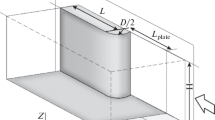Abstract
The paper discusses the supersonic flow around a blunt smooth body by a stream of viscous gas with subsonic injection from the surface of the body. The effect of various injection cycles on the physical flow characteristics ahead of the body are studied in [1, 2]; the problem is considered in the approximation of a boundary layer. The nonuniform composition of the gas ahead of the body, chemical reactions between the various components, and the effect of radiation are taken into account. For a number of flow cycles, which are of practical importance, it will be of interest to consider higher approximations in powers of ε [ε=1/√Re, see Eq. (1.1) below] in the shock layer ahead of the body and, in particular, to explain the action of the displacement effect and also the limits of applicability of the boundary-layer approximation assumed in [1, 2]. Extensive literature has been devoted to the asymptotics of the problem of flow around a blunt body of a viscous gas at high Reynolds numbers (see, for example, Van Dyke's book [3]). An investigation of the problem, based on the method of M. I. Vishik and L. A. Lyusternik, is contained in [4–6]. (The advantage of the use of Vishlik and Lyusternik's method in comparison with the method of internal and external expansion is discussed in [4].) The effect of injection on the flow has not been considered in the papers listed. In this paper, approximate solutions are constructed with an error of order ε and ε2 which take into account the effect of the injectionf on the flow\([f = (\rho wvw)/(\rho _\infty v_\infty ),f = O(1)]\). The approximate solutions are compiled from a more accurate nonviscous flow (external solution) and boundary-layer corrections. The boundary-layer corrections are constructed on a shock wave and a contact boundary in such a way that the solution would be continuous and quite smooth. For the external solution at the contact boundary, conditions are obtained which take into account the effect of viscosity.
Similar content being viewed by others
Literature cited
V. M. Ovsyannikov and G. A. Tirskii, “Failure of an axisymmetrical body of rotation, of a material of complex chemical composition in a flow of partially ionized air,” Izd. Akad. Nauk SSSR, Mekhan. Zhidk. i Gaza, No. 5 (1968).
É. A. Gershbein and G. A. Tirskii, “Flow of a viscous, heat-conducting, multicomponent gas in a shock layer, in the vicinity of truncations with intense injections,” Nauchn. Tr. In-ta Mekhan., Moskov. Gosudarst. Univers., No. 1 (1970).
M. Van Dyke, Perturbation Methods in Fluid Mechanics, Academic Press (1964).
L. A. Chudov, “Higher approximations in a boundary layer. (Method of boundary-layer corrections and the method of joined expansions.),” in: Some Applications of the Method of Networks in Gasdynamics [in Russian], Vol. 2, Izd. Moskov. Gosudarst. Univers., Moscow (1971).
A. A. Markov and L. A. Chudov, “Investigations of the flow of a viscous gas at quite high Reynolds numbers,” in: Numerical Methods of the Mechanics of Continuous Media fin Russian], Vol. 2, Pt. 2 (1971).
A. A. Markov, “Asymptotic investigation of the flow of a viscous gas from a zone of shock compression,” in: Some Applications of the Method of Networks in Gasdynamics [in Russian], Pt. 2, Izd. Moskov. Gosudarst. Univers., Moscow (1971).
M. Van Dyke, “Theory of a compressible boundary layer in second approximation, with application to flow around blunt bodies by a hypersonic flow,” in: Investigation of Hypersonic Flows [in Russian], Mir, Moscow (1964).
T. D. Taylor and B. S. Masson, “Supersonic flow past blunt bodies with large surface injection,” 19th Internat. Astronaut. Congress, Vol. 3, New York (1968).
V. P. Stulov, “Strong injection at the surface of a blunt body in a supersonic flow,” Izv. Akad. Nauk SSSR, Mekhan. Zhidk. i Gaza, No. 2 (1972).
V. P. Stulov, “The equations of a boundary layer in a radiating gas,” Izv. Akad. Nauk SSSR, Mekhan. Zhidk. i Gaza, No. 1, 68 (1971).
M. J. Casarella and Y. Choo, “Displacement effects of the laminar mixing of two parallel streams,” Aeronaut. Quart.,19, No. 4 (1968).
I. N. Murzinov and G. P. Shinkin, “ Laminar mixing of identical flows in the presence of a pressure gradient,” Izv. Akad. Nauk SSSR, Mekhan. Zhidk. i Gaza, No. 2 (1972).
Author information
Authors and Affiliations
Additional information
Translated from Izvestiya Akademii Nauk SSSR, Mekhanika Zhidkosti i Gaza, No. 1, pp. 69–77, January–February, 1974.
Rights and permissions
About this article
Cite this article
Markov, A.A. Investigation of supersonic flow around a blunt body with injection for high Reynolds numbers. Fluid Dyn 9, 52–59 (1974). https://doi.org/10.1007/BF01016309
Received:
Issue Date:
DOI: https://doi.org/10.1007/BF01016309




